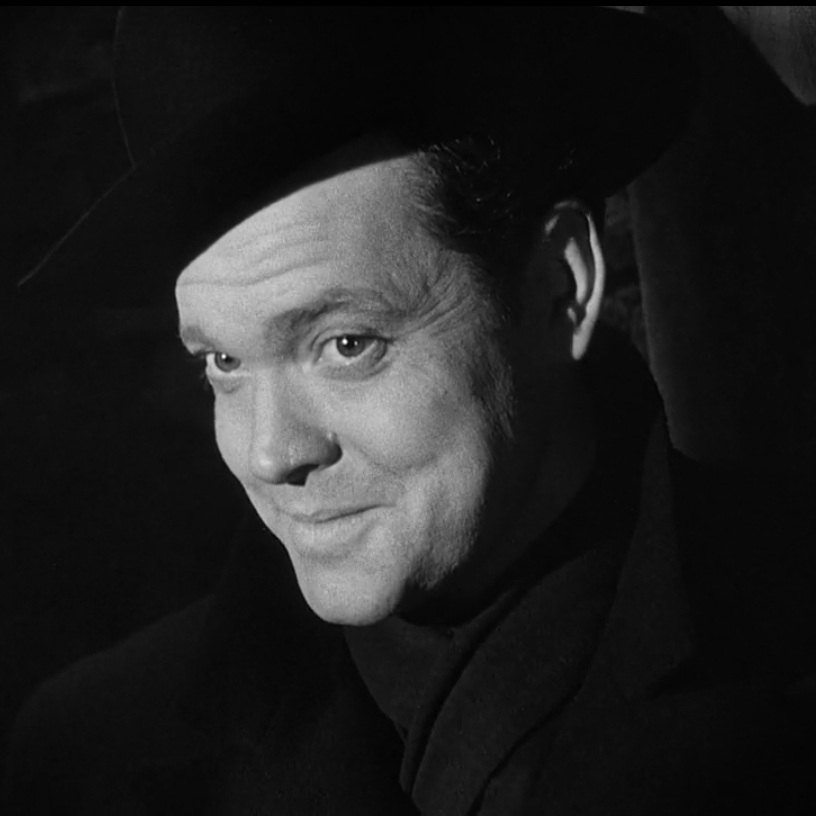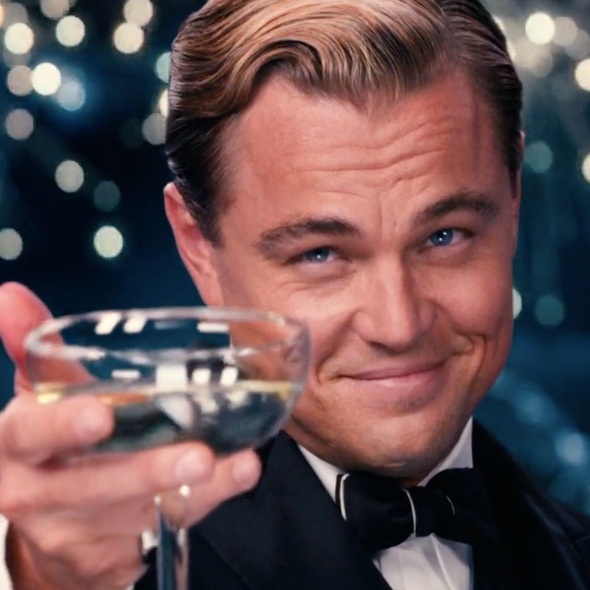One Big Joke
Four years after the end of World War II, there was still rubble on the streets of Vienna. The shockwaves of war were still being felt. Terror was apparent in the understanding of how low man could sink, how evil humans could become. This is the world of noir thrives: one of distrust and darkness. Filmed on the location of the war’s aftermath, The Third Man utilized the time and era to tell a classic noir tale. Director Carol Reed created a nightmarish world where morality is as warped as the shadows and the dark characters who hide therein. Everything in the story is plausible, and yet, there are hints of a shift in reality where black magic alters the Viennese streets and everything above or below.
Reed’s film is almost all a big joke. The beginning unravels with the visual of zither strings below the credits, evoking the ever-present shadows of cell bars in film noir, yet the sensation is immediately dispelled by the cartoonish tones played by Anton Karas. The music is followed by the narration of Reed himself. Title cards are displayed above the strings of a zither that is plucked to play the theme of the movie while the names pass by. The lines of the strings evoke common symbolic imagery in film noir. Resembling the bars of a jail cell, these ever-present shadows are depicted in this film over a cartoonish instrument that plays repeatedly without the accompaniment of other instruments.
As the credits end, the music continues and meets up with a narration spoken by Reed. The director effectually informs the audience that he is going to tell them a story by presenting a dead body floating in a river. “Of course a situation like that does tempt amateurs but, well, you know, they can't stay the course like a professional,” he remarks. This dark humor—mixed with the comedic music and the director’s own depiction of this story—apprises the viewer that this is all a joke in more ways than one. Though his voice does not return again in the movie, it sets a darkly comedic tone for the film that can be seen when the narrator suddenly introduces a character: “Oh, I was going to tell you, wait, I was going to tell you about Holly Martins, an American.” After the introduction, Holly Martins is seen in a train that is moving toward the left side of the screen. This is important to note since, in the classic language of cinema, this indicates a regression—a journey backwards—as the western eye is accustomed to reading from left to right. Martins is then seen heading towards his friend, Harry Lime, but walks under a ladder—a notorious symbol of bad luck. He enters Lime’s home and the person to whom he speaks to can barely speak his language. That person is the porter and he tells Holly, while pointing upwards, that his friend is in hell.
Each of these elements is building the world for Holly Martins to enter. It is a strange world where four different nations live together and struggle to understand each other. It is a place of bad luck for Holly, one where he has regressed backward from the American world of idealism to the cold streets of Austria. Even heaven and hell are confused in this place, as ambiguity clouds judgment and language acts as a barrier.
Holly Martins later walks with Anna, Harry’s lover, to a planned meeting with the porter. At his arrival, he is greeted by a crowd of people and the message conveyed to him in broken English is that the porter “is kaput.” Suddenly a child, the son of the porter, approaches Holly Martins and begins to cry out in German. Everyone—with the exception of Holly—realizes that he is being accused of murder. When Anna informs him, Holly runs away from the crowd with her, followed by the boy, in a demented game of hide-and-go-seek. This game is played out over and over with Martins being chased by racketeers, Limes by Martins, and eventually, Limes by the combined armed forces of Vienna. While a sting is being set up for Harry Limes, an old man tries to sell balloons to Major Calloway. A meeting between Harry and Holly takes place on a Ferris wheel. Shadows are distorted to look like those of giants. Rubble distorts the street itself. Simultaneously, a zither plays along, laughing at the idealist who is laughing at the audience. It keeps on laughing, like the impish smile on Harry Limes’ face when he gets caught in what he sees as just one elaborate prank. It’s a world where “there isn’t enough for two laughs,” and yet, the film itself seems to be laughing anyway. It is a horrifying and carnivalesque sense of humor—one characteristic of film noir.
Rubble distorts the street itself. Simultaneously, a zither plays along, laughing at the idealist who is laughing at the audience.
The hero of the noir film tends to be one that is pessimistic and lacking morals. There is no true hero in noir and the protagonist of this film is one who does not belong in the world of the film or in its genre at all. He is an idealistic author of “cheap paperback novelettes.” He sees himself as a cowboy, and the army, led by Major Calloway, as the sheriff. In this world, which he writes about, there is a simple balance of good and evil how heroes are recognizable by the outfits they wear and everything is solved by the time the final page is turned. Nonetheless, the streets of 1949 Vienna are not suited for Holly Martins; yet he seems to be the only one who doesn’t realize this. Military men attempt to send him on a plane while Anna tries to tell him to return home. Even a crowd of art enthusiasts walk out on him as he fails to properly answer a single question asked of him. As Holly Martins walks the streets of Vienna, he is being watched. The porter’s wife keeps her eyes on him as he goes over the crime scene of Harry’s “death,” while Baron Kurtz observes Limes’ friend at the former’s funeral. The camera repeatedly shows Holly Martins in angular shots, emphasizing how out of place he is and how surreal the world is around him. The film captures the bombarded scenery of the streets of Vienna, which The Third Man develops a language that says: “Go home. You are out of place in this strange, strange world.”
This idealistic man, protecting his friend to the very end comes to learn of the power of corruption when he hears that Major Calloway was trying to catch his friend. Holly asks him why he wasn’t chasing murderers and the Major responds: “Well, you could say that murder was part of his racket.” It is an arrogant response to stand up for his friend, Limes, who he believes was just mixed up in some bad business. Martins tries to hit him, again and again. It is only when he sees the bodies of children harmed by watered-down penicillin is he able to understand the truth and how little he had really known. Then he turns on his friend, waiting to trap him while drinking at a local bar.
Harry Limes is very reminiscent of the character Jay Gatsby from F. Scott Fitzgerald’s The Great Gatsby. He is a racketeer, he calls his friend “old man” repeatedly, and he holds his friend’s fascination. Even his famous grin can remind a viewer of Leonardo DiCaprio’s smile as the titular character in Baz Luhrmann’s The Great Gatsby. Yet, once again, the world asserts itself. In the 1920s, a Gatsby figure was the American Dream personified. He could be idealized and appreciated, but in a world of corruption and a lack of morality, the suave and smiling trickster becomes a sociopathic near-murderer trying to make a buck.
Just then, a cowboy enters a town ravaged by war and greed. Riding in on a steel horse, he plans to find a position of import, so he can protect the people and return these shambles to their former glory. The only problem is that the cowboy is not a cowboy, the horse is a train that is taking him the wrong way, the position is nonexistent, and there is no chance to fix the town. Holly Martins is a man out of his element and everybody else knows it. He has come to a world of cruel games—one without heroes or clear villains. This world continues to laugh at him throughout his visit as Carol Reed tells the audience about the “poor chap.” By the time the music winds to an end and the leaves begin to blow away, even the viewers begin to laugh at him, as he foolishly waits on the side of a road for a girl who is not stopping. For a girl who keeps on moving forward into a world that is not meant for him.
By Benjamin Wallin
Benjamin Wallin is the Editor-in-Chief of Refract Magazine and has been writing about film since his freshman year at Baruch College.
Illustrations done in collaboration with the New Media Artspace at Baruch College. The New Media Artspace is a teaching exhibition space in the Department of Fine and Performing Arts at Baruch College, CUNY. Housed in the Newman Library, the New Media Artspace showcases curated experimental media and interdisciplinary artworks by international artists, students, alumni, and faculty. Special thanks to docent Jose Benitez for creating artwork for this piece.
Check the New Media Artspace out at http://www.newmediartspace.info/



